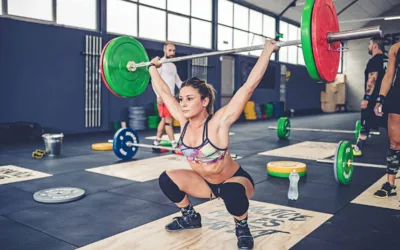Kettlebell Training for Strength & Conditioning

Kettlebells are funny-looking in the world of fitness equipment, but they’re insanely useful for building your strength and conditioning. We’d argue it’s necessary to learn how to use them properly. In the spirit of spreading valuable information, here’s a piece from one of our knowledgeable coaches on how to do both strength and ballistic movements with kettlebells.
Jack McCormick has been a coach and trainer since 2009. He’s worked in a range of settings from college sports performance to tactical S&C. Read on to learn all about kettlebells from him!
Jack McCormick

Change the Way You Train
Kettlebells Are Your Friends
When I was first introduced to kettlebells in 2007 I honestly thought they seemed gimmicky. They looked nothing like a dumbbell, barbell, or any machine I was familiar with. I had major doubts about their legitimacy as a training tool.
Now I’m proud to say I’ve been a certified kettlebell instructor for the past seven years. I use them in my programming extensively.
I’m a believer in the idea “methods are many, but principles are few.” No one particular tool is the end-all be-all for fitness, so learning to master them all has major advantages.
Some exercises lend themselves best to a kettlebell, or sometimes a KB is the only piece of equipment you have available. Whatever the case, being familiar with kettlebells and the variety of ways they can be used is a valuable feather for any athlete to have in their cap.
In this article, I’m diving into the primary kettlebell movements as well as progressions for each, and some recommendations along the way. The details and finer points of each of these movements can be articles on their own, but this crash-course will give you an idea of the various ways KBs can be used to build effective strength and conditioning in a fun way.
Kettlebell Strength Movements
There are five primary movement patterns I consider when creating a strength program with kettlebells:
- Hinge
- Squat
- Pull
- Press
- Carry
There are other valuable movements that don’t technically fall into these categories, but these five movements form the core of my training plans. Let’s get into them!
Hinge
Picking up a kettlebell off the ground is the first step to beginning any strength movement. KB deadlifts are also the foundation for any of the ballistic movements used for power/conditioning.
The kettlebell deadlift allows the weight to start in between your feet instead of slightly in front like with a barbell. It’s a nice first step in learning to load your hinge position, because the external load does not have to clear your knees during ascent.
The first way I progress the single kettlebell deadlift is with the double kettlebell deadlift. Obviously this increases the complexity of the movement with more load. Notice that the athlete uses a slightly wider stance to accommodate the width of two KBs.
Another way I will progress the deadlift is with the single-leg deadlift, using either unsupported stance or in a “kickstand” stance. I see value in learning both of these movements — unilateral strength is important.
The single-leg deadlift offers more challenge by creating a heavy balance demand. This can progress the regular-stance deadlift by focusing on the force production for each leg. Unilateral work like this also develops your balance and stability through a narrower base or by only having one point of contact with the ground.
Squat
The goblet squat is a nice way to load the squat pattern for a couple of reasons. First, it allows you to easily deal with the posterior weight shift required to squat. Second, it allows you to manage load without the compressive force on the spine that a barbell has.
One goblet squat progression is the one-arm kettlebell front squat. This movement teaches you how to maintain the racked position with a kettlebell, which you need to master for heavier loads. It also provides an asymmetrical load that challenges your stability.
Keep in mind: you need to be able to get the bell into the racked position to complete this movement. The most effective way to do this is to learn the “cheat clean.” You should be comfortable using the hip mechanics of the swing to safely guide the kettlebell up to the racked position. You can also use both hands to cheat clean for a heavy goblet squat.
The next progression is a double kettlebell front squat. Once you’re comfortable with a single bell, we can add another one to the other side. The big key with this exercise is knowing that in order to safely load the movement and be effective, you need to be comfortable with the double kettlebell clean. This includes coming out of the front rack position and safely returning the kettlebells to the floor. Practice with light KBs. Once you have this down, the double kettlebell front squat is an effective strength builder!
Pull
Single-arm supported kettlebell rows are a great pulling movement for upper body strength. A kettlebell is more comfortable than a dumbbell for this movement, because the handle is situated directly above the rest of the weight instead of in the middle. This makes the weight less “wobbly” and easier to pull properly.
I like to use this movement for horizontal pulling as my go-to when someone only has a kettlebell available. Get your form right with the video above and start working these into your program!
Press
One of my favorite exercises in all of strength and conditioning, whether using a KB or not, is the single-arm kettlebell military press. I love this movement because it requires you to develop tension in your entire body instead of just focusing on your arm and shoulder.
If you have the proper shoulder mobility to do overhead strength movements, the one-arm KB military press puts the weight on the back of your forearm. This does two things: first, it places the weight directly in alignment over the elbow joint instead of out to the sides like with a dumbbell. Second, the bell resting on the back of the forearm creates an external rotation force on your shoulder. It forces you to train and develop shoulder stability better than with a dumbbell overhead press.
I once trained to pass a test that required me to do a single-arm kettlebell military press with a bell that was close to half my bodyweight. Training for this taught me how to create tension, position my bodyweight to use my center of mass, and use my breath effectively more than any other experience.
Similar to the double kettlebell front squat, I progress this movement to a double kettlebell military press. This is a much more challenging version. Like the front squat, you should be proficient with a double kettlebell clean first to ensure you have the front rack position down.
Carries
I find carries to be tremendously beneficial — there’s a huge bang for your buck value to such a simple concept. There are many different carry varieties you can perform depending on your skill level and programming. Farmer carries, suitcase carries, and overhead carries are some I use often.
The biggest benefits of the carry is the demand for maintaining a neutral spine and encouraging good postural integrity. A less obvious benefit is the reflexive contralateral hip stability demand that occurs with each step.
One of my favorite carry variations is a double KB front rack carry. The double front rack position requires you to support the kettlebells up against your body. It works your core, especially when performed with actively tightened armpits to engage the lats. Pretend you have a $100 bill in each armpit that you don’t want to lose as you walk.
Kettlebell Ballistic Movements
The most well-known kettlebell movements are the ballistic ones. These movements make more sense using a kettlebell rather than a dumbbell. They’re tremendous for developing power and conditioning.
The most commonly utilized ballistic kettlebell movements are the two-arm swing, the one-arm swing, the clean, snatch, push press, and jerk.
All of these movements can be performed with one or two kettlebells (the caveat being that a double KB swing is performed with one in each hand). I like to bias programming for my athletes in this order: two-arm swing, one-arm swing, KB clean and KB snatch. Because this article is meant to be a crash-course in kettlebells, those are the main ballistic movements I’ll focus on for now.
The Kettlebell Swing
The kettlebell swing is the foundation for all of the ballistic kettlebell movements. In order to do a double KB press or double KB front squat, one must get the bells into the front rack position. To do this, you need to be confident in both the double and single kettlebell clean, which requires mastery of the single and double kettlebell swing.
When we work backwards from the execution of some of the more advanced movements, it’s obviously important to have a strong foundation with the kettlebell swing. Used for higher weight and lower reps (4-6 or so), the swing can be great for developing power. When done for higher reps with lower weight (8-15 for example) it can be an excellent conditioning tool.
The hip mechanics of the swing are extremely important to get right. Once the bells pass through your legs and you hit hip extension, it’s the bell path and influence of the upper extremities that changes the movement. A well-executed double clean or single-arm snatch should have the same hip mechanics as the two-arm swing.
The amount of power necessary will vary (a snatch has the bell finishing in the overhead position, and a clean has the bell finish in the racked position near the shoulders), but the hip mechanics should look the same. You can think of the amount of power being generated as a volume dial on a speaker system. You must get comfortable turning the dial up and down to get the right amount of power from your hips. This takes practice, but with time and focus it’s a very valuable skill in kettlebell training.
Psst, be sure to check out this article for a more comprehensive breakdown of the kettlebell swing.
Single-Arm KB Swing
The one-arm swing is slightly more challenging than the two-arm swing, because the nature of the asymmetrical load creates a rotational force on the torso that we need to counteract. A well-executed single-arm swing should look mostly the same from the set-up through the end of the movement.
You’ll want to set up as if you’re doing a two-arm swing, then take one hand off the kettlebell and bring it out to the side. Nothing else about the posture should change. The one-arm swing is the bridge between a basic kettlebell swing and a kettlebell clean or snatch.
Kettlebell Clean
Although I don’t use the kettlebell clean extensively as an exercise by itself, it’s critical to understand how to do them if you want to do anything with heavier bells in the racked position. One of the most important things to understand about the kettlebell clean, whether single or double, is that it is different from an Olympic weightlifting clean.
The kettlebell clean is about getting the bells from the ground into the racked position as efficiently as possible. It’s kind of a means to an end. To finish the movement, you want to guide the bells up to the racked position and “spear” your hand through so they rest comfortably on the fronts of your shoulders. Avoid “plopping” the kettlebells on your wrists or shoulders. A common complaint of people using kettlebells early on is the discomfort of the bells landing, but that usually means you need to work on the timing of your spear motion.
The most useful tip I have is to try to punch your hand through the kettlebell faster than you think you should so the kettlebell meets your shoulder comfortably. Performed correctly, it looks fluid. If you struggle with the bell flopping onto your wrists, you’re likely waiting too long to punch your hand through.
Kettlebell Snatch
The kettlebell snatch is a more advanced movement — highly effective for conditioning and also very demanding from a technique perspective. The snatch takes the coordination of the single-arm swing to a new level by requiring you to finish with the bell overhead in a stable lockout position.
It’s critical to become comfortable with the one-arm swing before going into snatches. Notice how the hip mechanics of the demonstrator in the video are virtually the same in both movements. I also recommend being comfortable with one-arm swings as well as understanding the concept of loosely cradling the kettlebell in your fingers and not “over gripping” it.
Points of Performance
- The kettlebell snatch requires you to have the shoulder mobility to be in a proper lockout position overhead. One way that snatch is taught is by starting at the top position of a military press. From there you learn how to cycle the bell back down in between your legs, through the bottom position of a single-arm swing to park the bell in front of you. If you don’t have the shoulder mobility to finish in a full lockout position, work on that before attempting KB snatches.
- The snatch also requires you to be highly competent with the single-arm swing and the basic kettlebell swing even before that. Master these two movements, then the KB clean before attempting the snatch to save yourself a lot of trouble and ensure you are on a road to success.
One of my favorite things about the different ballistic movements is how technical they are. I’ve been performing swings and snatches for roughly 13 years, and I still feel like I’m tweaking my technique. Like a surfer on a hunt for the ever elusive “perfect wave,” I feel the swing, clean, and snatch all offer the same challenges.
Some of my favorite workouts are like this:
15 minute EMOM (every minute on the minute)
4 single-arm snatches each side
It’s only one movement, but that gives me 120 opportunities to practice the movement with roughly 40 seconds to think about those reps and self-audit what felt good and what didn’t. Practicing the movement repeatedly and trying different cues/drills can help refine your technique. The satisfaction of searching for the “perfect wave” is equally as powerful in my mind as the physical conditioning benefits of the movements.
For those of you who have never used kettlebells, use this guide and the videos to really get your form down. Practice with light weights and find a coach who can safely teach you the movements and progressions in person. When incorporated properly and safely, kettlebells can be a tremendous addition to your program and can provide a fun method of training using just one piece of equipment.
Disclaimer: The views and opinions expressed in this article are my own and not those of my employer nor the organization I am certified by. This article was written on my own personal computer and not as part of any work done for my employer.
Find Your Perfect Training Plan
Sometimes all you need to reach your destination on your fitness journey is an expert guide. We've got you covered. Browse from thousands of programs for any goal and every type of athlete.
Try any programming subscription free for 7 days!
Related articles
3 Ways to Improve Mobility Without Stretching
Are you still trying the endless foam rolling and stretching exercises to get that deep squat position? We know how important mobility is for great, or even GOOD performance. All professional athletes have some comfortability in end ranges of motion. So, what else do...
The Ultimate Guide to Lunges: Queen of all Glute Exercises
Your glutes are the largest muscle group in your body. They’re responsible for almost everything your legs do—walking, running, jumping, squatting, lunging, and just standing upright. As far as moving through space goes, strong glutes are the bedrock of overall...
A Beginner’s Guide to Steel Mace Training
Author: Jesse Grund
Mace training will make you a better mover without it’s not confining you to a fixed space or predetermined range of motion. Second, it’s an offset load with 80 to 90 percent of the weight in the head. You’re also constantly having to resist rotation, which creates greater core engagement.

Join the community
Sign up for the latest training news and updates from TrainHeroic
Support
Made with love, sweat, protein isolate and hard work in Denver, CO
© 2023 TrainHeroic, Inc. All rights reserved.







